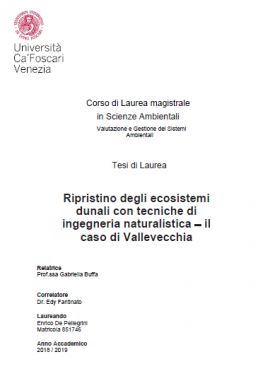The effectiveness of mobile dune restoration work at the Vallevecchia site
Dune ecosystems are increasingly threatened by human disturbance and pressure. This causes an alteration of the plant communities and of the balances that regulate the formation of coastal dunes.
The plant component of coastal ecosystems ensures the growth and continuous development of the dune; however, it is the component of dune ecosystems that is most affected by human disturbance. The lack of vegetation caused by disturbance triggers erosion processes that impoverish the structure and functionality of the entire ecosystem.
In view of the increasing loss of surface area and the degradation of the remaining areas, ecological restoration measures are an ideal solution for safeguarding the biodiversity of coastal ecosystems. Restoration measures are generally concentrated where anthropogenic pressure has been excessive and the conservation status of the ecosystem is compromised.
;
The research work that led to the thesis entitled "Restoration of dune ecosystems using naturalistic engineering techniques - the case of Vallevecchia" made it possible to assess the effectiveness of the restoration work carried out by the LIFE REDUNE project at the Vallevecchia (Caorle) site.
In particular, the restoration of the mobile dunes, as an essential component of coastal ecosystems, was carried out in 5 phases: physical reconstruction of the dune profile, stabilization, planting of nuclei of vegetation proper to the habitat, creation of new accesses to the beach with restrictions and signs, monitoring.
Transplanting took place in November 2018; afterwards, the plantings were monitored using the permanent plot technique. Squares of vegetation of 1m by 1m are monitored periodically to assess the survival of the transplanted species and the evolution of the habitat.
Initial analyses identified two distinct groups of plots: plots located in undisturbed neo-dunes and plots located in disturbed neo-dunes (despite the precautionary measures taken at the beginning of the project). The disturbance, due to the large number of tourists at this site and the lack of respect for the rules, has caused plants to fail to take root in some areas of the restoration, with the consequent loss of biodiversity. On the contrary, in the undisturbed areas most of the transplanted species took root, demonstrating strong vitality, given by a remarkable growth of the individuals in terms of height, new shoots or leaves and cover..
Moreover, following the restoration work, and in the absence of disturbance, it was possible to observe the appearance of other species which in turn developed considerably. At the beginning of the project, only four species were recorded, but by the end of the project, 12 species had been monitored. This demonstrates the effectiveness of the restoration work. However, it is very important that the work is not affected by disturbance events, which would nullify the whole goodness of the project and the survival of the ecosystem.
Dune ecosystems are among the most ecologically and scenically important in the world and therefore need to be safeguarded..
;
References:
"Restoration of dune ecosystems with naturalistic engineering techniques - the case of Vallevecchia" Enrico De Pellegrini, Master thesis in Environmental Sciences, University Cà Foscari Venice



